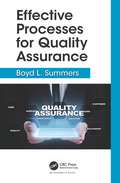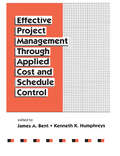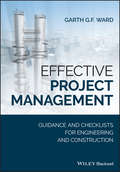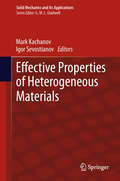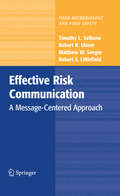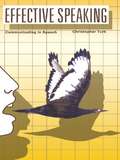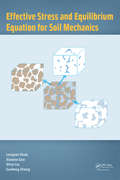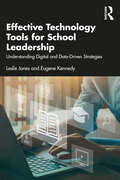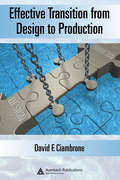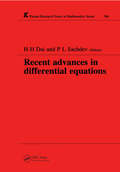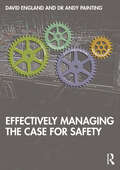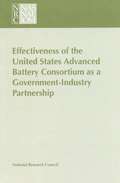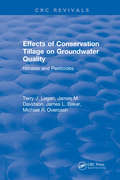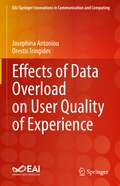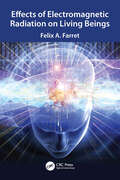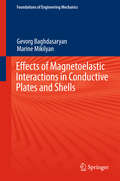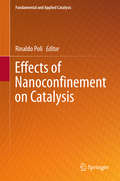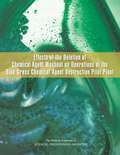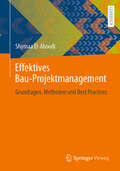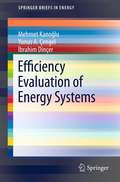- Table View
- List View
Effective Processes for Quality Assurance
by Boyd L. SummersDriving innovation can reduce costs for companies, institutions, military programs, and successful businesses. Quality is key to successful innovation. Delivery of complex products must have high quality to reduce customer problems and defects. This book explains how to integrate Quality Assurance processes to produce compliant product management and gap analysis. It shows how Quality Assurance provides a common operating framework in which best practices, improvements, and cost avoidance activities can be shared. Effective Processes for Quality Assurance emphasizes improving process execution and reducing operational costs. It also focuses on how Quality Assurance personnel must support companies, institutions, military programs, and successful businesses by encouraging a cooperative, proactive approach and ensure compliance through management and team member participation. Lean and Agile can provide a competitive advantage, and this practical reference explains how to implement these two principles to deliver products that have fewer defects. It also explains: Quality Assurance methods Measuring benefits of Quality Assurance process improvement Quality Assurance performance and improvement Risk management Quality Assurance improvement with metrics Effective processes for Quality Assurance Quantitative process performance and commitments Quality Assurance plans Quality Assurance for customers and suppliers Supporting software configuration Effective Processes for Quality Assurance covers the critical issues for implementing Quality Assurance processes that can deliver high-quality products successfully.
Effective Project Management Through Applied Cost and Schedule Control
by Kenneth K. Humphreys James BentThis work outlines a state-of-the-art project control and trending programme, focusing on advanced applied-cost and schedule-control skills for all phases of a project at both owner and contractor level. It contains information on the three major aspects of the total project programme: the techniques and procedures utilized for a project; the exper
Effective Project Management: Guidance and Checklists for Engineering and Construction
by Garth G.F. WardA practical and accessible guide to managing a successful project Effective Project Management is based around an activities and action check list approach to project management. It provides a guide to the basic principles and the disciplines that managers need to master in order to be successful. The author’s check lists approach (based on his years of practical experience on projects) ensure that project managers are following valid processes, helping them to be innovative in their approach to developing plans and resolving problems. In addition, the author’s check list pick and mix format is designed to be flexible in order to meet the individual needs of the reader. Effective Project Management also contains some information on the theories underpinning project management. Knowledge of the theory helps in the understanding of how project management works in practice. In addition to the book’s check lists of what activities need to be performed, the author offers suggestions on how tasks could be carried out. This important resource: Covers a wide range of project management topics including the project management process, programme and portfolio management, initiating and contracting a project, personal skills and more Offers a highly accessible guide to the author’s verified check list approach Presents flexible guidelines applicable for a wide range projects Includes guidance for project managers at all levels of experience Written for project managers working on engineering or construction projects, Effective Project Management reviews all aspects of a project from initiation and execution to project completion together with the specialist topics and personal skills needed to manage projects effectively.
Effective Properties of Heterogeneous Materials
by Igor Sevostianov Mark KachanovThe book contains state-of the-art reviews in the area of effective properties of heterogeneous materials - the classical field at interface of materials science and solid mechanics. The primary focus is on thermo-mechanical properties, materials science applications, as well as computational aspects and new opportunities provided by rapidly increasing computer powers. The reviews are at the level that is appropriate for a substantial community of researchers working in this field, both at universities and in the industry, and to graduate students. The book can be used as supplementary reading to graduate level courses.
Effective Risk Communication
by Robert Littlefield Robert R. Ulmer Matthew W. Seeger Timothy L. SellnowThe overlying purpose of this book is to construct a communication based approach to risk communication. In doing so, this book establishes a message-centered focus to risk communication. Section one of the book establishes definitions and parameters of risk communication, identifies the complex audience expectations for risk messages, and introduces a model of best practices for effective risk communication. In section two, the best practices are applied in four robust case studies. Section three includes chapters devoted to developing a mindful approach to risk communication, ethical considerations of risk communication, and a final chapter that discusses future developments of risk communication.
Effective Speaking: Communicating in Speech
by Christopher TurkEffective Speaking provides the hard scientific information about audience psychology, text preparation, presentation methods, voice production, body language and persuasive advocacy which will help would-be speakers improve their performance. The emphasis throughout is on practical self-help, on methods which have been shown to work, with clear explanations of just why they are effective.
Effective Stress and Equilibrium Equation for Soil Mechanics
by Longtan Shao Xiaoxia Guo Shiyi Liu Guofeng ZhengThe concept of effective stress and the effective stress equation is fundamental for establishing the theory of strength and the relationship of stress and strain in soil mechanics and poromechanics. <P><P>However, up till now, the physical meaning of effective stress has not been explained clearly, and the theoretical basis of the effective stress equation has not been proposed. Researchers have not yet reached a common understanding of the feasibility of the concept of effective stress and effective stress equation for unsaturated soils. Effective Stress and Equilibrium Equation for Soil Mechanics discusses the definition of the soil skeleton at first and clarifies that the soil skeleton should include a fraction of pore water. When a free body of soil skeleton is taken to conduct internal force analysis, the stress on the surface of the free body has two parts: one is induced by pore fluid pressure that only includes normal stress; the other is produced by all the other external forces excluding pore fluid pressure. If the effective stress is defined as the soil skeleton stress due to all the external forces excluding pore fluid pressure, the effective stress equation can be easily obtained by the internal force equilibrium analysis. This equation reflects the relationship between the effective stress, total stress and pore fluid pressure, which does not change with the soil property. The effective stress equation of saturated soils and unsaturated soils is unified, i.e., o˜=o˜t –Seuw–(1–Se)ua. For multiphase porous medium, o˜=o˜t –u*,u*=Seiui(i=1,2,...,M). <P><P> In this book, a theoretical formula of the coefficient of permeability for unsaturated soils is derived. The formula of the seepage force is modified based on the equilibrium differential equation of the pore water. The relationship between the effective stress and the shear strength and deformation of unsaturated soils is preliminarily verified. Finally, some possibly controversial problems are discussed to provide a better understanding of the role of the equilibrium equation and the concept of effective stress.
Effective Technology Tools for School Leadership: Understanding Digital and Data-Driven Strategies
by Leslie Jones Eugene KennedyThis book prepares educational leaders with the knowledge needed to critically evaluate, select, and use technological tools to be effective school leaders. Authors Jones and Kennedy explore the technology tools needed to support the full range of responsibilities of a school leader, including management and administration, personnel and evaluation, security and safety, instructional leadership, organizational culture and climate, external relationships, and action research. Each chapter unpacks advantages and pitfalls of various technological tools and includes case scenarios that contextualize these ideas for readers. Chapter content is also aligned with The Professional Standards for Educational Leaders (PSEL), the National Educational Leadership Preparation Standards (NELP), and the International Society of Technology Standard in Education (ISTE) standards. This timely and important book adds to the toolbox for educators preparing to become effective and cutting-edge school leaders.
Effective Transition from Design to Production
by David F. CiambroneTaking a new product from the design stage to large-scale production in a profitable, efficient manner can challenge the processes of even the most advanced companies. Lapses in these processes drive up the cost of new products, and hinder their launch into the marketplace. Effective Transition from Design to Production provides an expeditio
Effective Writing Strategies for Engineers and Scientists
by Donald C. WoolstonThis easy-to-read, concise book is filled with examples, hints, reminders and reviews designed to help engineers and scientists develop effective writing skills. Use the book to learn to write better reports, memos, and journal articles and keep it close at hand when you have questions about organization, clarity and style, writing and revising rough drafts, graphics, workplace writing, computers in writing, and legal issues in writing. The book also contains four helpful appendices on common errors, equations and abbreviations, preparing manuscripts for publication, and documenting information sources. Effective Writing Strategies for Engineers and Scientists provides easy training for the type of writing required of engineers and scientists, gives specific advise for conveying complicated information, and describes how to synthesize information according to specific writing strategies. It is a "must" for every scientist's and engineer's bookshelf.
Effectively Managing the Case for Safety
by David England Andy PaintingThis book examines how safety failings during the use of any designed product or system—be it a car, a building, or a chemical plant—can be mitigated through effective understanding of the conditions and controls surrounding its use. Drawing on historical failures and their own real-world experience, Dr Andy Painting and David England explain how corporate culture, engineering safety, personnel selection, and proper safety auditing are key ingredients to maintaining safety in all aspects of an organization’s operations. This effective strategy is also crucial to linking back to the design of future products in establishing where operational failures have been identified and can therefore be "designed out" in future iterations. The book challenges silo thinking among the various safety-related disciplines and shows how this can be counter-productive to effective safety management. Effectively Managing the Case for Safety draws on key features from engineering, design, and health and safety processes, which, when used cohesively, promote a better working environment for everyone and help to reduce wasted time, money, and effort for any organization. Safety is tracked from the initial design stage through any product’s entire service life and includes evidence of how safety affects, and is affected by, all those who interact with a product, system, or project. Following their first book, An Effective Strategy for Safe Design in Engineering and Construction, which demonstrated how current construction regulations can be used as a framework to ensure that safety is embedded into the design of virtually any product from machinery to buildings, this follow up book defines what safe is, how it is initially derived, and how the operational safety of any product, during its in-use phase, can be managed and assessed. The result is not only to ensure compliance with relevant regulations but also to actively ensure the ongoing safety of all those who interact with a product or project.
Effectiveness and Impact of Corporate Average Fuel Economy (CAFE) Standards
by National Research CouncilSince CAFE standards were established 25 years ago, there have been significant changes in motor vehicle technology, globalization of the industry, the mix and characteristics of vehicle sales, production capacity, and other factors. This volume evaluates the implications of these changes as well as changes anticipated in the next few years, on the need for CAFE, as well as the stringency and/or structure of the CAFE program in future years.
Effectiveness of Bank Filtration for Water Supply in Arid Climates (IHE Delft PhD Thesis Series)
by Ahmed Ragab MahmoudIn many developing countries, water demand is increasing while surface- and groundwater resources are threatened by pollution and overexploitation. Hence, a more sustainable approach to water resources management and water treatment is required. In this capacity, bank filtration is a natural treatment process that makes use of the storage and contaminant attenuation capacity of natural soil/rock. However, BF is site-specific and a significant knowledge gap exists regarding the design and management of bank filtration systems, particularly in developing countries. This research aimed to address these gaps and contribute to the transfer of bank filtration to developing countries. This study comprised both column and batch laboratory-scale experiments to determine the effect of environmental variables such as temperature, raw water organic composition and redox conditions on the removal of chemical pollutants such as organic matter, micro-pollutants and heavy metals as well as the mobility of iron, manganese and arsenic under anaerobic conditions. Ultimately, the effectiveness of BF for supplying high drinking water quality was assessed in a case study in Egypt. The study showed that more than 80% of biodegradable organic matter was removed during infiltration at temperatures between 20 and 30 °C. However, humic compounds enriched during BF, required post-treatment. Moreover, high humic content of infiltrating water reduced the removal of heavy metal and promoted the release of metal (loids) into the infiltrating water, rendering it more feasible to install BF wells within surface water systems with low levels of organic matter. Moderately-hydrophobic organic micropollutants were most persistent and required infiltration times longer than 30 days for complete elimination even at high temperatures (>20 °C). Finally, design parameters such as the number of infiltration wells should be configured to minimise the proportion of polluted groundwater in the pumped water. Overall, this study provides insight into the effectiveness of BF in removing chemical pollutants from surface water and proposes guidelines for the successful application of BF in developing countries where arid conditions and high temperatures prevail.
Effectiveness of Protected Areas in Conserving Biodiversity: A Worldwide Review (Strategies for Sustainability)
by David Rodríguez-Rodríguez Javier Martínez-VegaThis book addresses the effectiveness of existing protected areas at conserving the diversity of genes, species and ecosystems on land and at sea. The book synthetizes the main biodiversity conservation outcomes of protected areas in the 2010-2019 decade, drawing on a systematic literature review of scientific publications and case studies from around the world demonstrating successes and failures. It provides region-specific results for land and sea ecosystems as well as for developed and developing countries. It also reviews current methodological approaches used to assess protected area effectiveness. The work is timely, since there is growing concern on the global biodiversity crisis among researchers, government organizations and the general public, as demonstrated by the 2030 targets established by the UN Sustainable Development Goals for Life Below Water (SDG 14) and Life On land (SDG15). The book is written in an easy and enjoyable style using numerous pictures, tables and graphs to make the content more engaging and understandable. The main intended audiences of the book are academics, from post-graduate students to university lecturers, and senior researchers in the fields of biodiversity conservation, sustainable development and environmental policy, as well as protected area managers and practitioners.
Effectiveness of the United States Advanced Battery Consortium as a Government-Industry Partnership
by Committee to Review the U.S. Advanced Battery Consortium's Electric Vehicle Battery Research Development Project Selection ProcessInformation on the Effectiveness of the United States Advanced Battery Consortium as a Government-Industry Partnership
Effects Conservation Tillage On Ground Water Quality: Nitrates and Pesticides
by Terry J LoganNowadays the environmental sustainability of the cropping systems is increasingly requested by the consumers. Conventional tillage practices, totally turning over the soil between the vineyard rows, may cause erosion due to rain as well as structure destruction of the soil in the long term. Conservation tillage is a soil management technique, poorly widespread in Sardinia, allowing cover cropping between vineyard rows. Furthermore, this technique makes the canopy development control of herbage possible by cutting it up during specific phenological phases. Conservation tillage usually involves direct benefits to farmers such as increasing soil fertility as well as reductionof tillage costs, soil erosion and carbon dioxide (CO2) emissions in the atmosphere. This long term trial, during at least five years aims to assess the conservation tillage impact on chemical-physical soil characteristics in comparison with traditional tillage by evaluating the change of organic matter, C.E.C. and availability of major plant nutrients in the soil and to estimate their probable rise. The field plots are located in a 35% slope condition vineyard, showing massive erosion problem and organic matter low content. A split/plot design with four replications was set up, with the comparison between conservation and traditional tillage apart as main plots. Moreover, the effects of two different irrigation levels were evaluated in the subplots of each main plot. At the beginning of the trial (2011) a pedological survey was made. Three soil profiles were described and sampled along the field slope and soil sampling in each plot were made both to characterize the soil and to find the zero point. The soil chemical and physical characteristics were monitored through a second soil sampling made at the end of 2013. Conservation tillage caused increasing organic matter content and C.E.C. values. As for major plant nutrients in soil, results were more uncertain. Grapevine yield and quality parameters did not show any negative effect when passing from conventional to conservation tillage techniques. The trial provided a preliminary positive evaluation of conservation tillage. However, more years are required to confirm this trend.
Effects of Data Overload on User Quality of Experience (EAI/Springer Innovations in Communication and Computing)
by Josephina Antoniou Orestis TringidesThis book introduces a unique perspective on the use of data from popular emerging technologies and the effect on user quality of experience (QoE). The term data is first refined into specific types of data such as financial data, personal data, public data, context data, generated data, and the popular big data. The book focuses the responsible use of data, with consideration to ethics and wellbeing, in each setting. The specific nuances of different technologies bring forth interesting case studies, which the book breaks down into mathematical models so they can be analyzed and used as powerful tools. Overall, this perspective on the use of data from popular emerging technologies and the resulting QoE analysis will greatly benefit researchers, educators and students in fields related to ICT studies, especially where there is additional interest in ethics and wellbeing, user experience, data management, and their link to emerging technologies.
Effects of Electromagnetic Radiation on Living Beings
by Felix A. FarretThe objective of this book is to show in detail how electromagnetic waves existing in the environment can affect the electrochemical currents present in the brains and bodies of living beings that serve to communicate with their internal organs as well as with other living beings. These electromagnetic waves are distributed intensively by current means of communication (television, cell phones, radar, medical equipment, electrical machines, electrical networks, etc.) and by the stars in the Universe. Such waves can affect in one way or another the electrochemical currents of living beings, which seem to be currently interpreted as sensations, hypnosis, telepathy, intuition, spells, mediumship, visions and precognition, as well as other less widespread forms, such as telekinesis, radiesthesia, clairvoyance, precognition and teleportation. Several world-famous examples of these possibilities are illustrated in the final chapter of this book.Key Features: 14 examples of diverse international case studies included Challenges conventional ways of thinking by exploring the intersection of electromagnetic waves and extrasensory perception Equips readers with insights into the various effects of electromagnetic waves in daily life, which promotes awareness of their environment and its different influences and how they impact people Provides an engineering framework for understanding extrasensory beliefs and aims to explain the concept of historical brain believing in a better manner
Effects of Herbicide-Tolerant Crop Cultivation
by Michel Beckert Yves DessauxOverall, this work identifies key points to be taken into account when drawing up guidelines that govern the use of herbicide-tolerant (HT) crops in order to preserve the effectiveness of this innovation over time. This multidisciplinary expert report, based on an international literature review, assesses the effects of the cultivation of crops possessing HT traits. HT crops may appear to be useful complementary tools when farmers are facing certain difficult weed-management situations or in the context of a diversification of weed-control strategies. Their repeated use, however, can rapidly induce changes in the weed flora that can constitute more complex challenges in terms of weed control. Issues coming up with the development of agricultural production systems including HT crops are the objects of this expert report: what are the perceptions of these varieties by society and the reasons for their adoption by farmers? Are the savings on herbicides promoted by seed companies long-lasting? Can the cultivation of HT crops impact biodiversity?
Effects of Magnetoelastic Interactions in Conductive Plates and Shells
by Gevorg Baghdasaryan Marine MikilyanThis book investigates the stability and vibrations of conductive, perfectly conductive and superconductive thin bodies in electromagnetic fields. It introduces the main principles and derives basic equations and relations describing interconnected mechanical and electromagnetic processes in deformable electro conductive bodies placed in an external inhomogeneous magnetic field and under the influence of various types of force interactions. Basic equations and relations are addressed in the nonlinear formulation and special emphasis is placed on the mechanical interactions of superconducting thin-body plates with magnetic fields.
Effects of Nanoconfinement on Catalysis
by Rinaldo PoliThis book highlights the recent advances and state of the art in the use of functionalized nanostructured environments on catalysis. Nanoconfinements considered include well-defined molecular cages, imprinted self-assembled supramolecules, polymers made by living or controlled polymerization, metallorganic frameworks, carbon nanotubes, mesoporous inorganic solids, and hybrids thereof. Advantages of nanoconfinement of catalysts discussed include higher activities, improved selectivities, catalyst stabilization, cooperativity effects, simplified protocols for cascade syntheses, better catalyst recovery, and recyclability. The multiple applications that these materials offer are revolutionizing industrial sectors such as energy, electronics, sensors, biomedicine, and separation technology.
Effects of Wetland Conversion to Farming on Water Quality and Sediment and Nutrient Retention in a Tropical Catchment (IHE Delft PhD Thesis Series)
by Abias UwimanaThe study used a combination of landscape-scale synoptic surveys (catchment, reaches) and mesocosm surveys (experimental plots) to assess the impacts of conversion of natural valley-bottom wetlands to farming land on the water quality and retention of sediment and nutrients. The results showed that temperature, pH, electrical conductivity and dissolved oxygen concentration decreased, and total suspended solids (TSS) increased with storm water increase. Nitrogen (TN) and phosphorus (TP) accumulated in the catchment during the dry season and washed into the water courses during the early stages of the higher flows, with subsequent lower concentrations at the end of the rains due to dilution. Large proportions of the annual loads of TSS, TP and TN (93%, 60% and 67%, respectively) were transported during rainfall events that occurred in 115 days. Fishponds acted as temporal traps of TSS, TN and TP at the early stages of farming, and were a source of and TN and TP at the end of the farming period, in contrast to rice farming that generated sediments and nutrients early in the farming period and trapped them at the end of the farming season. Wetlands mostly acted as sinks but sometimes as a source of sediment and nutrients.
Effects of the Deletion of Chemical Agent Washout on Operations at the Blue Grass Chemical Agent Destruction Pilot Plant
by Engineering Medicine National Academies of SciencesThe United States manufactured significant quantities of chemical weapons during the Cold War and the years prior. Because the chemical weapons are aging, storage constitutes an ongoing risk to the facility workforces and to the communities nearby. In addition, the Chemical Weapons Convention treaty stipulates that the chemical weapons be destroyed. The United States has destroyed approximately 90 percent of the chemical weapons stockpile located at seven sites. As part of the effort to destroy its remaining stockpile, the Department of Defense is building the Blue Grass Chemical Agent Destruction Pilot Plant (BGCAPP) on the Blue Grass Army Depot (BGAD), near Richmond, Kentucky. The stockpile stored at BGAD consists of rockets and projectiles containing the nerve agents GB and VX and the blister agent mustard. Continued storage poses a risk to the BGAD workforce and the surrounding community because these munitions are several decades old and are developing leaks. Due to public opposition to the use of incineration to destroy the BGAD stockpile, Congress mandated that non- incineration technologies be identified for use at BGCAPP. As a result, the original BGCAPP design called for munitions to be drained of agent and then for the munition bodies to be washed out using high-pressure hot water. However as part of a larger package of modifications called Engineering Change Proposal 87 (ECP-87), the munition washout step was eliminated. Effects of the Deletion of Chemical Agent Washout on Operations at the Blue Grass Chemical Agent Destruction Pilot Plant examines the impacts of this design change on operations at BGCAPP and makes recommendations to guide future decision making.
Effektives Bau-Projektmanagement: Grundlagen, Methoden und Best Practices
by Shymaa El-AboodiDieses Lehrbuch ist eine pragmatische Mischung aus fundiertem Wissen, langjähriger Erfahrung und umfassender praktischer Umsetzung der wesentlichen Methoden des Projektmanagements. Der systematische Aufbau enthält praktische Anwendungshilfen für die Projektarbeit. Das Lehrbuch gibt einen verständlichen Überblick über die Methoden, Werkzeuge und Best Practices, die für eine effiziente Realisierung von Bau-Projekten genutzt werden können. Das Buch möchte Einsteiger:innen in die Thematik dabei unterstützen, die Herausforderung der Projektarbeit zu meistern und ihre Fähigkeiten und Kenntnisse als Projekt-Manager:in weiterzuentwickeln.
Efficiency Evaluation of Energy Systems
by Ibrahim Dincer Mehmet Kanoğlu Yunus A. ÇengelEfficiency is one of the most frequently used terms in thermodynamics, and it indicates how well an energy conversion or process is accomplished. Efficiency is also one of the most frequently misused terms in thermodynamics and is often a source of misunderstanding. This is because efficiency is often used without being properly defined first. This book intends to provide a comprehensive evaluation of various efficiencies used for energy transfer and conversion systems including steady-flow energy devices (turbines, compressors, pumps, nozzles, heat exchangers, etc.), various power plants, cogeneration plants, and refrigeration systems. The book will cover first-law (energy based) and second-law (exergy based) efficiencies and provide a comprehensive understanding of their implications. It will help minimize the widespread misuse of efficiencies among students and researchers in energy field by using an intuitive and unified approach for defining efficiencies. The book will be particularly useful for a clear understanding of second law (exergy) efficiencies for various systems. It may serve as a reference book to the researchers in energy field. The definitions and concepts developed in the book will be explained through illustrative examples.
